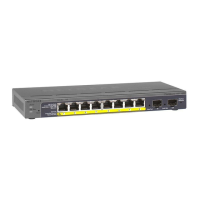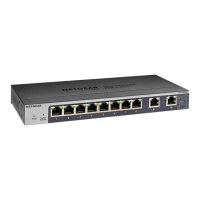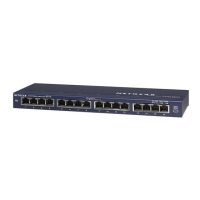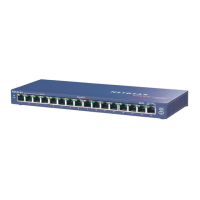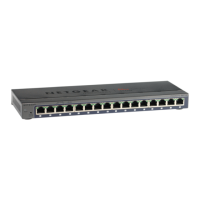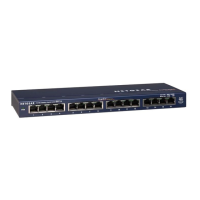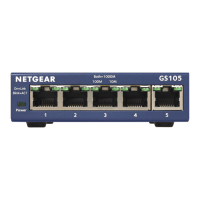8-Port Gigabit (PoE+) Ethernet Smart Managed Pro Switch with (2 SFP or 2 Copper Ports and)
Cloud Management
Configure Switching User Manual145
10. From the Hash Mode menu, select the load-balancing mode for a port channel (LAG):
• 1 Src/Dest MAC, incoming port.
This mode uses the source MAC address,
destination MAC address, and incoming port that are associated with the packet.
• 2 Src/Dest IP and TCP/UDP Port Fields.
This mode uses the source and destination
IP addresses and source and destination TCP or UDP port values that are associated
with the packet.
Note: The switch balances traffic on a port channel (LAG) by selecting one
of the links in the channel over which packets must be transmitted. The
switch selects the link by creating a binary pattern from selected fields
in a packet and associating that pattern with a particular link.
11. From the STP Mode menu, select the Spanning
Tree Protocol (STP) administrative mode
associated with the LAG:
• Disable. Spanning tree is disabled for this LAG.
• Enable. Spanning tree is enabled for this LAG. Enable is the default.
12. From the Link T
rap menu, select Enable or Disable to specify whether to send a trap when
the link status changes.
The default is Enable, which causes the trap to be sent.
13. From the LAG T
ype menu, select Static or LACP:
• Static. Disables Link
Aggregation Control Protocol (LACP) on the selected LAG. The
LAG is configured manually. The default is Static.
• LACP. Enables LACP on the selected LAG.
The LAG is configured automatically.
14. Click the Apply button.
Your settings are saved.
The following table describes the nonconfigurable information displayed on the page.
Table 28. LAG Configuration information
Field Description
LAG ID Identification of the LAG.
Active Ports Indicates the ports that are actively participating in the port channel.
LAG State Indicates whether the link is up or down.
Configure LAG membership
You can select two or more full-duplex Ethernet links to be aggregated together to form a link
aggregation group (LAG), which is also known as a port channel. The switch can treat the
port channel as a single link.

